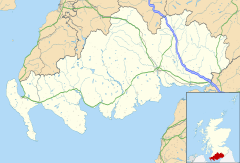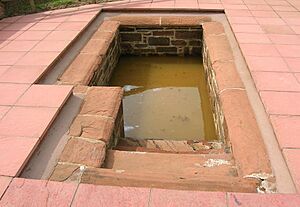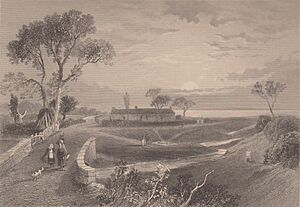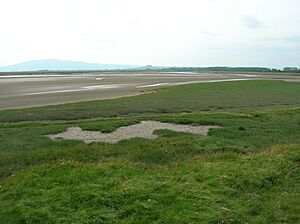Brow, Dumfries and Galloway facts for kids
Quick facts for kids Brow
|
|
|---|---|
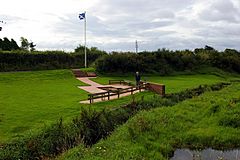 The Brow Well |
|
| OS grid reference | NY085675 |
| Council area | |
| Lieutenancy area | |
| Country | Scotland |
| Sovereign state | United Kingdom |
| Post town | DUMFRIES |
| Postcode district | DG1 |
| Dialling code | 01387 |
| Police | Dumfries and Galloway |
| Fire | Dumfries and Galloway |
| Ambulance | Scottish |
| EU Parliament | Scotland |
| UK Parliament |
|
| Scottish Parliament |
|
Brow is a small village, also called a hamlet, located in Scotland. It's about 3 kilometers from Ruthwell, near the Solway Firth. A small stream called the Raffles Burn (also known as the Brow Burn) flows through the area and into the Solway Firth at Lochar Bay.
Contents
History of Brow
The name 'Brow' might come from its location. It seems to 'face' or look out over the Lochar Water and the Solway Firth. In 1747, Brow had at least four buildings. It was on a small road between Ruthwell and Caerlaverock. In the 1800s, people could cross the sands and the Lochar Water from Brow to Blackshaw Point at low tide.
The Raffles Burn flows past Clarencefield, where it once powered a saw mill. It then goes through Brow Plantation and into the Solway Firth at Lochar Bay.
Brow was a stop for drovers, who were people moving cattle to England for sale. Around the time of Robert Burns, the hamlet had about twelve houses. One of these was a small inn, owned by James Morpeth. It was run by the Davidson family and was torn down in 1863.
Brow was known as a "poor man's spa." This was because it had a special well with iron-rich water and people could bathe in the sea nearby. The farm of Stanhope is on the other side of the burn. There was a crossing point (ford) there in the 19th century.
A local story says that the Roman Legions of Emperor Agricola landed at Brow a long time ago. It is also said that the first Scottish pigs were brought to Brow. Their appearance caused a lot of surprise among the people who saw them!
The Brow Merse is a part of the Caerlaverock National Nature Reserve. This is a special place for wildlife.
The Brow Well
The Brow Well, as it looks today, was built in the 20th century. It is a stone tank shaped like an 'L' with steps leading down. The water is rich in iron and was once taken from a pipe using an iron cup. A drain carries the water to the nearby Raffles or Brow Burn.
This is a Chalybeate (pronounced "ka-LIB-ee-at") well. This means its water contains iron and other salts. People believed these waters had many health benefits. Old maps from the 1700s and 1800s show that there were several "Mineral Wells" in the area.
An old picture from 1846 shows the well on the eastern side of the burn. The 1856 map shows the well in its current spot with a small building nearby. There are also signs of two other mineral springs on the other side of the Raffles or Brow Burn. However, they do not have any buildings around them.
Robert Burns' Visit to Brow
The famous Scottish poet Robert Burns was very ill in 1796. His doctors suggested he go to the Brow Well. They thought sea bathing, riding, and fresh country air might help him. Some people believe the idea of sea bathing was actually Burns' own.
He arrived around July 3rd and stayed for three weeks at the inn. He lodged in a room at the end of the building. The inn didn't serve port wine, which was part of his treatment. So, Burns was told to get some from the inn at nearby Clarencefield. Locals used to point out an old thorn tree near the well where he would sit.
While at Brow, Burns wrote several letters. He wrote to his friends asking for money and saying goodbye. He also wrote to his wife, Jean Armour, who was expecting a baby. He asked her mother for help. He even wrote to his brother Gilbert, mentioning his money problems and his poor health. Burns hoped to continue the treatment all summer.
During his stay, on July 5th, Maria Riddell sent her carriage to pick him up. He went to dine with her at Lochmaben. She said he looked like he was "touching the brink of eternity." His greeting to her was: "Well madam, have you any commands for the other world?"
Burns also visited Ruthwell Manse. He had tea with Mrs. Craig, the minister's widow. Her daughter, Agnes, tried to close a curtain to give Burns some shade. He replied: "thank you, my dear, for your kind attention; but oh, let him shine! he will not shine long for me!"
He had a horse with him, but he didn't want to ride in the rain. He asked his friend John Clark for his new "spring-cart," which was a comfortable ride. At first, Burns seemed to feel better. But by July 18th, he had to return to Dumfries. The sea bathing depended on the tides, and the good tides had passed. He sadly died in Dumfries on July 21st.
A twelve-year-old boy named Allan Cunningham saw Burns return home. He wrote that Burns "shook much, and stood with difficulty." He "stooped as if in pain, and walked tottering towards his door." Those who saw him then expected never to see him again.
Every year, the Southern Scottish Counties Burns Association holds a service at the Brow Well. This remembers Robert Burns, who died just four days after his last visit to the well on July 21, 1796.
Archaeology at Brow
In 1969, a green-glazed jug from the 15th or 16th century was found near the Brow Well. It was discovered in a ditch that was being dug. Also, a well-made flint arrow-head was found near the Brow Well some years ago. It was later made into a brooch.
Images for kids


